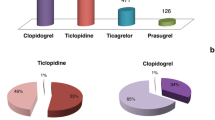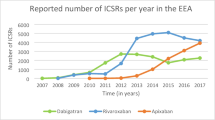Abstract
Background and Objective: Adverse drug reactions (ADR) are appreciably harmful or unpleasant effects, resulting from an intervention related to the use of a medicinal product, with a high burden for patients and considerable economic consequences. Comprehensive pharmacoeconomic evaluations of ADR are quite rare in Germany. It is the aim of this study to determine the hospital costs of gastrointestinal bleeding effects among users of phenprocoumon. Furthermore, based on calculations of the costs of genotyping and of new drugs like dabigatran, and also on information about patient self-management (PSM), options for reducing the financial burden are investigated.
Methods: The study is based on all patients suffering from ADR included in the database of the Pharmacovigilance Center Greifswald between 2006 and 2009 (n=80). DRGs were calculated on the basis of information provided by the Hospital Information System of the University Medicine Greifswald, which can be regarded as a monopolist within a rural area. Costs of genotyping were calculated by direct assessment of the used resources.
Results: Findings for the included 40 men and 40 women were quite similar. The average age was 74 ± 10 years. On average a patient spent 10 ± 7 days in hospital. All patients were multi-morbid (average number of diagnoses: 15 ± 7) and used several drugs (average number of co-medication: 9 ± 3). The hospital received on average €2821 per patient, with a range between €350 and €5900. The total costs of genotyping were €57. In the case of a dabigatran-based therapy avoiding ADR the corresponding DDD-based costs would rise from €0.21 to €7.78.
Conclusions: ADR-related costs can be increased by a more stringent application of PSM. The costs of genotyping were quite low. Because false positive test results are quite rare, tests are profitable even at a low bleeding risk. The replacement of vitamin k antagonists by new drugs like dabigatran might first of all improve the corresponding therapy. Whether it is possible to decrease the corresponding economic burden or not depends first of all on the corresponding drug price level.
Similar content being viewed by others
Literatur
Bundesministerium für Gesundheit und soziale Sicherung. Gesetz über den Verkehr mit Arzneimitteln. § 4 Sonstige Begriffsbestimmungen. 2011
Schnurrer JU, Frölich JC. Zur Häufigkeit und Vermeidbarkeit von tödlichen unerwünschten Arzneimittelwirkungen. Internist 2003; 44(7): 889–95
Bates DW, Cullen DJ, Laird N, et al. Incidence of adverse drug events and potential adverse drug events. Implications for prevention. ADE Prevention Study Group. JAMA 1995; 274(1): 29–34
Jha AK, Kuperman GJ, Teich JM, et al. Identifying adverse drug events: development of a computer-based monitor and comparison with chart review and stimulated voluntary report. J Am Med Inform Assoc 1998; 5(3): 305–14
Easton KL, Parsons BJ, Starr M, et al. The incidence of drug-related problems as a cause of hospital admissions in children. Med J Aust 1998; 169(7): 356–9
Fiss T, Ritter CA, Alte D, et al. Detection of drug related problems in an interdisciplinary health care model for rural areas in Germany. Pharm World Sci 2010; 32(5): 566–74
Wilmer A, Louie K, Dodek P, et al. Incidence of medication errors and adverse drug events in the ICU: a systematic review. Qual Saf Health Care 2010; 19(5): e7
Schneeweiss S, Hasford J, Göttler M, et al. Admissions caused by adverse drug events to internal medicine and emergency departments in hospitals: a longitudinal population-based study. Eur J Clin Pharmacol 2002; 58(4): 285–91
Goettler M, Schneeweiss S, Hasford J. Adverse drug reaction monitoring—cost and benefit considerations. Part II: cost and preventability of adverse drug reactions leading to hospital admission. Pharmacoepidemiol Drug Saf 1997; 6 (Suppl. 3): S79–90
Schalekamp T, Klungel OH, Souverein PC, et al. Effect of oral antiplatelet agents on major bleeding in users of coumarins. Thromb Haemost 2008; 100(6): 1076–83
Bussey HI. Transforming oral anticoagulation by combining international normalized ratio (INR) self testing and online automated management. J Thromb Thrombolysis 2011; 31(3): 265–74
McWilliam A, Lutter R, Nardinelli C. Health Care Savings from Personalizing Medicine Using Genetic Testing: The Case of Warfarin. AEI-BROOKINGS JOINT CENTER FOR REGULATORY STUDIES. 2006
Stehle S, Kirchheiner J, Lazar A, et al. Pharmacogenetics of oral anticoagulants: a basis for dose individualization. Clin Pharmacokinet 2008; 47(9): 565–94
Manolopoulos VG, Ragia G, Tavridou A. Pharmacogenetics of coumarinic oral anticoagulants. Pharmacogenomics 2010; 11(4): 493–6
Oldenburg J, Bevans CG, Fregin A, et al. Current pharmacogenetic developments in oral anticoagulation therapy: the influence of variant VKORC1 and CYP2C9 alleles. Thromb Haemost 2007; 98(3): 570–8
Bodin C, Verstuyft DA, Tregouet A, et al. Cytochrome P450 2C9 (CYP2C9) and vitamin K epoxide reductase (VKORC1) genotypes as determinants of acenocoumarol sensitivity. Blood 2005; 106(1): 135–40
Schalekamp T, Brasse BP, Roijers JF, et al. VKORC1 and CYP2C9 genotypes and phenprocoumon anticoagulation status: interaction between both genotypes affects dose requirement. Clin Pharmacol Ther 2007; 81(2): 185–93
Wadelius M, Chen LY, Lindh JD, et al. The largest prospective warfarin-treated cohort supports genetic forecasting. Blood 2009; 113(4): 784–92
Wood S. New Warfarin Labeling Reminds Physicians About Genetic Tests to Help Guide Initial Warfarin Dosing. Medscape Medical News 2007, August
Ezekowitz MD, Wallentin L, Connolly SJ, et al. Dabigatran and warfarin in vitamin K antagonist-naive and -experienced cohorts with atrial fibrillation. Circulation 2010; 122(22): 2246–53
Freeman JV, Zhu RP, Owens DK, et al. Cost-effectiveness of dabigatran compared with warfarin for stroke prevention in atrial fibrillation. Ann Intern Med 2011; 154(1): 1–11
Pressemitteilung der AOK Berlin-Brandenburg vom 27.08.2010. AOK Berlin-Brandenburg und AOK Mecklenburg-Vorpommern fusionieren. Erhältlich unter URL: http://www.forium.de/redaktion/aok-berlin-brandenburg-und-aok-mecklenburg-vorpommern-fusionieren/Forium [Abgerufen am 17.01.12]
Statistisches Bundesamt. Verbraucherpreisindex für Deutschland. 2010
RKI und SBA. Gesundheitsberichterstattung des Bundes “Gesundheit in Deutschland”. 2007
Statistisches Bundesamt. Datenreport 2006. 2006
Bundesministerium der Finanzen. AfA-Tabelle für die allgemein verwendbaren Anlagegüter ab 1.1.2001
Wyse DG. The AFFIRM trial: main trial and substudies — what can We expect? J Interv Card Electrophysiol 2000; 4 (Suppl. 1): 171–6
Go AS, Hylek EM, Phillips KA, et al. Implications of stroke risk criteria on the anticoagulation decision in nonvalvular atrial fibrillation: the Anticoagulation and Risk Factors in Atrial Fibrillation (ATRIA) study. Circulation 2000; 102(1): 11–13
Windeler J, Antes G, Behrens J, et al. Randomisierte klinische Studien (RCTF). Z Evid Fortbild Qual Gesundhwes 2008; 102(5): 321–5
Grashoff K. Polypharmazie: Durch Behandlung krank. DAS PTA MAGAZIN 2009; 2: 24–9
van den Bemt PM, Egberts AC, Lenderink AW, et al. Risk factors for the development of adverse drug events in hospitalized patients. Pharm World Sci 2000; 22(2): 62–6
Bufe A, Frey S, Briswalter S. Durch Blutungen verursachte Kosten bei der Therapie des akuten Koronarsyndroms in Deutschland. Herz 2009; 34(6): 479–84
Mehran R, Pocock SJ, Nikolsky E, et al. A risk score to predict bleeding in patients with acute coronary syndromes. J Am Coll Cardiol 2010; 55(23): 2556–66
AOK-Bundesverband. Vereinbarte Basisfallwerte der DRG-Krankenhäuser von 2003 bis 2010. 2010
Siebig J. Landesweite Basisfallwerte: Wie hoch sind sie und wie geht es weiter? Das Krankenhaus 2005; 7: 559–64
Baumol J. Health care, education and the cost disease: A looming crisis for public choice*. Public Choice 1993; 77(1): 17–28
Dykes PC, Wheeler K. Critical Pathways — Interdisziplinäre Versorgungspfade. DRG-Management-Instrumente. Bern: Verlag Hans Huber, 2002
Eckman MH, Rosand J, Greenberg SM, et al. Cost-effectiveness of using pharmacogenetic information in warfarin dosing for patients with nonvalvular atrial fibrillation. Ann Intern Med 2009; 150(2): 73–83
Eng CMD, Cossman JMD. New Developments May Change Study Results. Comment on: Cost-Effectiveness of Using Pharmacogenetic Information in Warfarin Dosing for Patients With Nonvalvular Atrial Fibrillation. Ann Intern Med 2009
Aithal GP, Day CP, Kesteven PJ, et al. Association of polymorphisms in the cytochrome P450 CYP2C9 with warfarin dose requirement and risk of bleeding complications. Lancet 1999; 353(9154): 717–9
Higashi MK, Veenstra DL, Kondo LM, et al. Association between CYP2C9 genetic variants and anticoagulation-related outcomes during warfarin therapy. JAMA 2002; 287(13): 1690–8
Schwarz UI, Ritchie MD, Bradford Y, et al. Genetic determinants of response to warfarin during initial anti-coagulation. N Engl J Med 2008; 358(10): 999–1008
Margaglione M, Colaizzo D, D’Andrea G, et al. Genetic modulation of oral anticoagulation with warfarin. Thromb Haemost 2000; 84(5): 775–8
Rieder MJ, Reiner AP, Gage BF, et al. Effect of VKORC1 haplotypes on transcriptional regulation and warfarin dose. N Engl J Med 2005; 352(22): 2285–93
Anderson JL, Horne BD, Stevens SM, et al. Randomized trial of genotype-guided versus standard warfarin dosing in patients initiating oral anticoagulation. Circulation 2007; 116(22): 2563–70
Patrick AR, Avorn J, Choudhry NK. Cost-effectiveness of genotype-guided warfarin dosing for patients with atrial fibrillation. Circ Cardiovasc Qual Outcomes 2009; 2(5): 429–36
Caraco Y, Blotnick S, Muszkat M. CYP2C9 genotypeguided warfarin prescribing enhances the efficacy and safety of anticoagulation: a prospective randomized controlled study. Clin Pharmacol Ther 2008; 83(3): 460–70
You JH, Wong RS, Waye MM, et al. Warfarin dosing algorithm using clinical, demographic and pharmacogenetic data from Chinese patients. J Thromb Thrombolysis 2011; 31(1): 113–8
Griese N, Goebel R, Schulz M. Rabattverträge: Pharmazeutische Bedenken bei Phenprocoumon? Pharmazeutische Zeitung 15/2010
Zimmer Germany GmbH. Auch künstliche Gelenke kommen in die Wechseljahre. 26.06.2008
Sawicki PT. A structured teaching and self-management program for patients receiving oral anticoagulation: a randomized controlled trial. Working Group for the Study of Patient Self-Management of Oral Anticoagulation. JAMA 1999; 281(2): 145–50
Taborski U, Wittstamm FJ, Bernardo A. Cost-effectiveness of self-managed anticoagulant therapy in Germany. Semin Thromb Hemost 1999; 25(1): 103–7
Gadisseur AP, Kaptein AA, Breukink-Engbers WG, et al. Patient self-management of oral anticoagulant care vs. management by specialized anticoagulation clinics: positive effects on quality of life. J Thromb Haemost 2004; 2(4): 584–91
Horstkotte D, Piper C. Improvement of oral anticoagulation therapy by INR self-management. J Heart Valve Dis 2004; 13(3): 335–8
Koertke H, Minami K, Boethig D, et al. INR self-management permits lower anticoagulation levels after mechanical heart valve replacement. Circulation 2003; 108 (Suppl 1): II75–8
McCahon D, Fitzmaurice DA, Murray ET, et al. SMART: self-management of anticoagulation, a randomised trial [ISRCTN19313375]. BMC Fam Pract 2003; 4: 11
Christensen TD, Johnsen SP, Hjortdal VE, et al. Self-management of oral anticoagulant therapy: a systematic review and meta-analysis. Int J Cardiol 2007; 118(1): 54–61
Heneghan C, Alonso-Coello P, Garcia-Alamino JM, et al. Self-monitoring of oral anticoagulation: a systematic review and meta-analysis. Lancet 2006; 367(9508): 404–11
DeMonaco HJ, von Hippel E. Reducing medical costs and improving quality via self-management tools. PLoS Med 2007; 4(4): e104
Lafata JE, Martin SA, Kaatz S, et al. Anticoagulation clinics and patient self-testing for patients on chronic warfarin therapy: A cost-effectiveness analysis. J Thromb Thrombolysis 2000; 9 (Suppl. 1): S13–9
Lafata JE, Martin SA, Kaatz S, et al. The cost-effectiveness of different management strategies for patients on chronic warfarin therapy. J Gen Intern Med 2000; 15(1): 31–7
Klar HG, Leo-Gröning I. Selbstmanagement: Patienten messen ihre Blutgerinnung. Pharmazeutische Zeitung. 2004. Erhältlich unter URL: http://www.pharmazeutischezeitung.de/index.php?id=titel_29_2004 [Abgerufen 18.01.2012]
Bauman ME, Black KL, Massicotte MP, et al. Accuracy of the CoaguChek XS for point-of-care international normalized ratio (INR) measurement in children requiring warfarin. Thromb Haemost 2008; 99(6): 1097–103
Newall F, Monagle P, Johnston L. Home INR monitoring of oral anticoagulant therapy in children using the CoaguChek S point-of-care monitor and a robust education program. Thromb Res 2006; 118(5): 587–93
Testa S, Alatri A, Paoletti O, et al. Reorganisation of an anticoagulation clinic using a telemedicine system: description of the model and preliminary results. Intern Emerg Med 2006; 1(1): 24–9
Marstedt G. Patienten-Selbstmanagement: Kostensparend, therapiefördernd und trotzdem wenig verbreitet. Forum Gesundheitspolitik vom 17.4.2007. Erhältlich unter URL: http://www.forum-gesundheitspolitik.de/artikel/artikel.pl?artikel=0657 [Abgerufen 18.01.2012]
Völler H, Braun S. Neue Aspekte des INR-Selbstmonitoring. Hamostaseologie 2008; 28(4): 231–3
Author information
Authors and Affiliations
Corresponding author
Rights and permissions
About this article
Cite this article
Schwebe, M., Marschall, P. & Fleßa, S. Schwerwiegende Arzneimittelnebenwirkungen von Phenprocoumon: stationäre Kosten der gastrointestinalen Blutungen und Einsparungspotentiale. Pharmacoeconomics-Ger-Res-Articles 10, 17–28 (2012). https://doi.org/10.1007/BF03320775
Published:
Issue Date:
DOI: https://doi.org/10.1007/BF03320775




